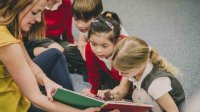Doorways Into Activism
Books can give children an entry point to taking action in the outside world by providing examples of how to address bullying, bias, and injustice.
Consider the following book characters:
- In The Smallest Girl in the Smallest Grade, by Justin Roberts, Sally has keen observation skills that enable her to see a lot of mean behavior and bullying—and one day she decides to take a stand. (For ages 3–6)
- In Maddi’s Fridge, by Lois Brandt, Sofia enlists her mother in seeking to help her friend Maddi, who doesn’t have much food in her refrigerator because her family is poor. (For ages 4–8)
- In Separate Is Never Equal, by Duncan Tonatiuh, Sylvia is excited about her first day at her neighborhood school, but she and her siblings are prevented from attending because they’re Mexican. Her family organizes a lawsuit that brings about an end to segregated schooling in California. (For ages 6–10)
- In Same Sun Here, by Silas House and Neela Vaswani, River and his family face mountaintop removal mining in the Kentucky Appalachians and stage a demonstration to raise visibility and fight back. (For ages 9–12)
- In Gracefully Grayson, by Ami Polonsky, Grayson is a transgender girl in middle school who is looking for acceptance and finds allies in unexpected places. (For ages 10–14)
Allies and Activists
These characters—both real and fictional—have something in common. They find ways to combat bias or injustice. They take action. (The Anti-Defamation League has information and educator discussion guides for all of these books.)
The books, spanning from picture books to young adult literature, highlight the ways people can act as allies on a personal level or engage in activism on a larger scale. Allies are those who speak out on behalf of or take actions that are supportive of someone else, and activists get involved in activities that are meant to achieve political or social change.
Because books can resonate with children, they can serve as important tools in helping children feel powerful and take action. When children are targeted or witness bias, bullying, and injustice, it can be difficult for them to know what to do. They may stay silent, stew in their anger, or feel demoralized and powerless. As they seek out strategies to deal with bias, discovering books that inspire them to be allies and activists can make a difference.
Over the past several years, there’s been an increasing awareness about the need to have diverse books in homes and schools in order to provide young people with both “mirrors” to build self-esteem in their own identities and “windows” to let them understand people who are different from them.
There has been less emphasis on what we might call “doorway” books, literature that illustrates what actions young people can take to challenge the bullying, bias, and injustice they see in their lives. These books are doorways in that they provide an entry point to taking action in the outside world. They can provide historical and current day role models of people who experienced and witnessed injustice and then went out to confront it.
Books can be an outlet and a tool for helping young people understand that they can make a difference as they explore how to address bias, hate, incivility, and injustice. As they look for strategies to address inequities in schools, communities, and society as whole, books about social justice and ally behavior provide models, stories, and inspiration.
Adapting These Ideas in the Classroom
As you read books with young people, consider these ideas for classroom implementation to extend the learning:
Read-alouds, book clubs, and discussions: No matter the age, children enjoy being read to, and doorway books are wonderful opportunities to learn about allyship and activism and achieve reading goals at the same time. You can also divide students into book clubs and have them read different books and then come together as a class to talk about common themes and where the books diverge. Acting out favorite scenes is another way to extend the learning.
Written responses to literature: You can use discussion questions as writing prompts, have students write the next chapter or pages of the book as they imagine it, write diary entries of their favorite character, or write book reviews.
Social action projects: Use the stories from class discussions and student writing as springboards to discuss issues of bias and injustice in your students’ schools or communities. Discuss which issues require action and develop action plans for doing something about them.
Technology: Use video, social media, blogs, photography, and other technology to engage students in a different way. Use video to record a book talk, use Twitter and Instagram with tweens and teens to engage them in learning more about the subject or find out what others are saying about the book, or have students create a class blog about the different doorway books they read.
Connections between history and current events: These books can provide an opening to learn more about history as well as current events that connect with the subject matter of the book. When students have questions or want to dig deeper into the content, they can be engaged in research projects about the history related to the text.
